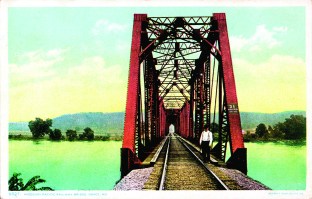After half a century of headaches the Army Corps of Engineers ceased operation of Lock & Dam No. 1 ten miles from the junction of the Osage and Missouri rivers. It saw little traffic and was a maintenance nightmare.
We recently ran across a 1956 newspaper article that mentioned a consternation we had not been aware of. When the Corps couldn’t keep the gates in the open position, they removed the set of gates on the lower lock, thus lowering the water level by five to five and a half feet upstream. Locals complained that they couldn’t get their boats over the riffles.
OSAGE LOCK, DAM LEASE NOT BEING SUGGESTED NOW
The Osage River Lock and Dam No. 1 property may be up for lease or sale in the future, but for the time being the U.S. Army Corps of Engineers “is reluctant to consider or recommend further leasing of the property.”
The Army Corps of Engineers position on sale or leasing of the property, which has popped up among organizations here in the past, was voiced by L. T. Col. Walton O. Threadgill acting district engineer in Kansas City.
A Jefferson City resident who owns a cottage on the Osage River revealed Army Engineers personnel were working on the site recently. The Corps of Engineers discontinued operation of the lock and dam in September, 1951. Lt. Col. Threadgill confirmed the report.
Some difficulties
He said that “difficulties were experienced in maintaining the gates in the open position” and on March 28 “the two gates at the downstream end of the lock were removed by field personnel of this office to eliminate further difficulties.”
The lock’s gates had been secured in an open position in September, 1951, to permit a free flow through the lock at all times, the colonel said. The Corps of Engineers did this when it pulled its last employee from the property.
But keeping the locks open is proving a big thorn for property owners above the lock and dam, a local resident said yesterday. He added that when a number of them built cottages there was five to five and a half feet of water so they could easily move their boats.
But with the lock at the open position permanently, there is “only 12 to 14 inches of water in normal stages on several shoals and we have difficulty moving our boats.”
How about leasing or purchase of the property? Some organizations have considered such a step with the view of converting the property into a wildlife haven and/or recreational area.
Office reluctant
Lt. Col. Threadgill, noting that a bill is before Congress to provide for the disposal of federally-owned property “at obsolete, canalized waterways and for other purposes,” said the district office, “is reluctant to consider or recommend further leasing of the property involved until congressional action is consummated.”
The bill was introduced in Congress during last year’s session but no final action was taken.
“It is anticipated that legislation will ultimately be adopted authorizing the disposal of the subject property but the conditions and methods of the disposal cannot be determined prior to such enactment,” the Colonel said.
No formal application
He added that, “several inquiries have been received by the Kansas city office, but no formal application to lease or purchase the property is on file in this office at this time.” While the Army Corps of Engineers has no employees assigned or stationed at the project, Lt. Col. Threadgill said, “periodic inspections are made, however to safeguard the government property.”
The Colonel said that cessation of operations at the lock and dam in 1951 “conforms with a nation-wide policy of discontinuing operations of obsolete waterways in order to achieve economy in costs of maintenance.”
Long history
The lock and dam had a long and undoubtedly colorful history before it was closed down in 1951. Records show it was completed in 1914. It is 42 feet wide and 229 feet long.
The project Lt. Col. Threadgill said, was authorized by the River and Harbor Acts approved on Sept. 19, 1890 and March 3, 1899. The project provided for a lock and dam near the mouth of the Osage River and for open channel work consisting of wing dams, training walls, removal of obstructions and dredgings between the mouth and Warsaw, Mo., a distance of 171 miles, “to obtain a uniform depth of 3 feet.”
Lt. Col. Threadgill said, “The wickets and weirs which formed the moveable crest of the dam were removed many years ago.”
In the heyday of the lock and dam, steamboats and rafts were “all important as a means of moving cargoes, but with the construction of good roads, railroads and highways over which the products of the area are now moved to market, the use of the Osage River Lock and Dam No. 1 dwindled to passage of only on occasion pleasure craft or fishing boat,” the colonel spelled out.
And he wrote: “The Osage River waterway has ceased to be an artery of commerce for the Osage valley. Since the operation of the lock and dam was of no benefit to commercial navigation, and the negligible collateral benefits did not justify the continuing operation of the structure at federal expense, the operation of the project was discontinued during September, 1951.”
In our next post, we’ll relate how a “bachelor and private eye” was suckered in to paying cash for this major liability.






